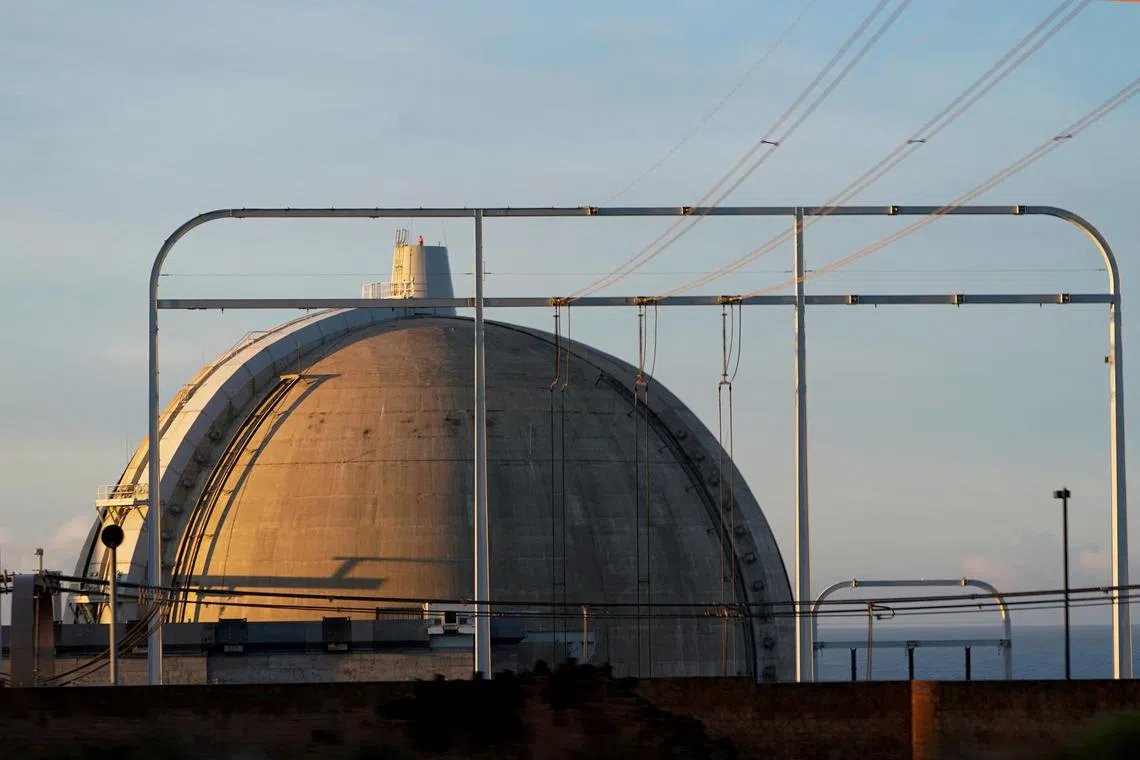Small reactor start-ups vie to push US into new nuclear era
Sign up now: Get ST's newsletters delivered to your inbox

One of two now-closed reactors at the San Onofre nuclear generating station at the nuclear power plant located south of San Clemente, California.
PHOTO: REUTERS
Follow topic:
HOUSTON - Several American start-ups are working on building a new generation of small reactors that could push nuclear energy into a new phase, with support from the US government.
During a recent hearing before the House Appropriations Committee, Secretary of Energy Jennifer Granholm restated the “importance of nuclear energy” for the current administration regarding America’s power supply.
But despite the Biden administration’s stated support for nuclear power, there are no new projects under way for any traditional nuclear reactors.
In fact, today’s 93 remaining legacy reactors – which provide around 18 per cent of the country’s electricity – are ageing fast; six reactors have already been decomissioned since 2017.
The future of the industry will likely rely on small modular reactors – or SMRs – similar to the ones currently powering submarines.
SMRs have been promoted as a cheaper option than legacy reactors, with shortened construction time and less fuel needed to power them, which translates into less nuclear waste.
“I’ve spoken to many utility CEOs and many of them simply stated that they plan to build SMRs, and not large reactors,” says Mr William Freebairn, senior managing editor at S&P Global.
Many SMRs will replace coal plants in remote locations where “the ability to place a really large unit is very limited”, he added.
Although SMR technology has been under development for decades, momentum is picking up, due in no small part to the push from the government and the recent adoption of the Inflation Reduction Act which will provide tax credits of up to 30 per cent of investments.
Several US companies are working on their own SMR or AMR (advanced modular reactor) designs.
But only one – from Portland’s NuScale – has been fully certified by the Nuclear Regulatory Commission (NRC). It had its approval granted only in January 2023, six years after the company filed its application.
Dr Bahram Nassersharif, nuclear engineering programme director at the University of Rhode Island, said: “Other countries around the world that are interested in this technology really watch what’s happening in the United States very carefully, and they kind of follow suit in terms of what’s been approved by the NRC.
“That’s kind of the stamp of approval that they accept.”
NuScale initially expected its pilot six-module plant to be fully operational by 2026 in Idaho Falls, Idaho, but delays have already pushed the deadline to 2030.
Time is of the essence, with 28 per cent of America’s coal-fired electric-generating capacity to be retired by 2035, according to an Energy Information Agency estimate.
US designs also face increasing competition abroad; some 70 to 80 SMR designs have already emerged in various countries, including South Korea, France and Russia.
Although it is leading the pack, NuScale’s costs are mounting. The expected bill for its Idaho plant is projected to be US$9.3 billion (S$12.4 billion), up 75 per cent from initial estimates. Almost half of this money will be provided by government subsidies.
Ten of the 36 public utilities that had signed on to help build the plant have dropped out of the group.
Mr Stephen Handy, a spokesman for Utah Associated Municipal Power Systems, said: “We are aggressively pursuing not only new participants, but also working to incentivise current participants to increase their subscription levels.”
Much safer
Mr Chris Levesque, president and chief executive of TerraPower, said: “The first project is always the hardest.”
TerraPower, a company backed by Mr Bill Gates, is expected to break ground in May on its first reactor called Natrium in Kemmerer, Wyoming. Natrium will be built close to a nearby power plant scheduled to close in 2028.
“There’s the design, which you don’t have to pay for more than once, the licensing with the safety authority, and then the learning curve, just building it for the first time,” Mr Levesque said.
Unlike the NuScale prototype which, like conventional reactors, uses pressurised water, Natrium relies on something called “molten salt technology”, which presents no risk of explosion and does not require a traditional bulky concrete containment structure.
Another American start-up, called Ultra Safe Nuclear Corporation (USNC), is aiming to have its plant in Champagne, Illinois, online as early as 2027. It has chosen a regulatory approach that it hopes will allow it to certify the various elements of its installation during construction.
As with other SMRs, USNC’s model includes standardised parts, which would significantly reduce costs and build times, said Mr Daniel Stout, nuclear manager of the Seattle company.
Americans remain divided on the use of nuclear energy, although the percentage of those who oppose it has fallen from 54 per cent in 2016, to 47 per cent in 2022, according to a 2022 Gallup poll.
SMR players say their reactors are safer than traditional ones, with some claiming that the new technology is not prone to serious incidents leading to irradiation and contamination, shielding them from a core meltdown like the one that occurred in Fukushima, Japan, in 2011.
“The burden is on us to prove to the independent regulators that we don’t need large evacuation plans, that our technology is that safe and does not warrant unnecessary plans to evacuate because our design precludes accidents that cause the need for evacuation,” Mr Stout said.
Dr Nassersharif said: “A lot was learnt from those major accidents and from minor accidents as well.
“All of those lessons learnt have been, to a great extent, incorporated into these new designs. So I believe that these reactors, in general, are much safer than the previous generation.” AFP

